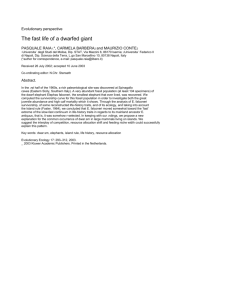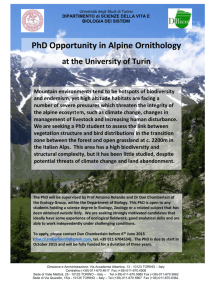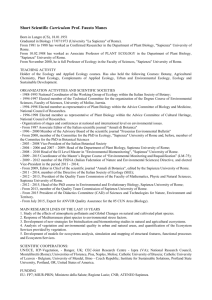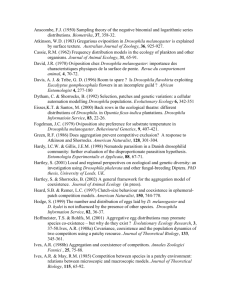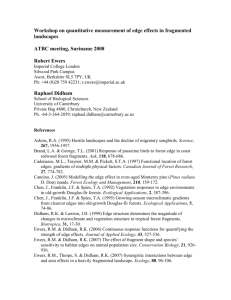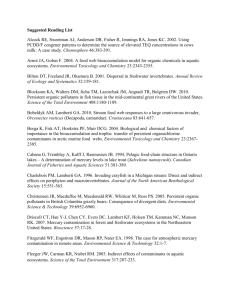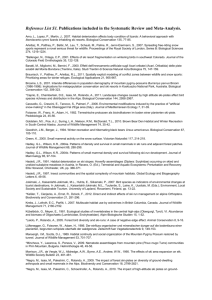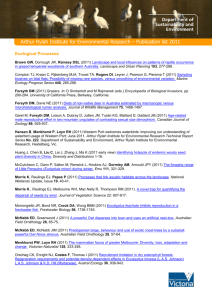Pinto-Coelho , R.M. - Fundamentos em Ecologia (Referências) 27.1
advertisement
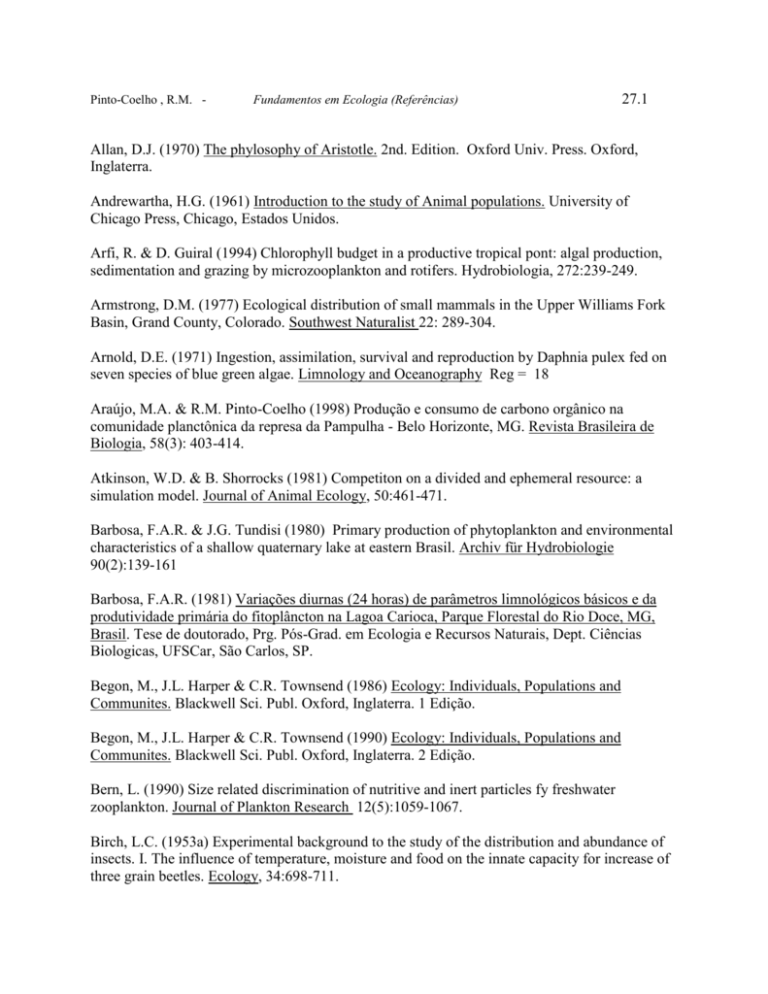
Pinto-Coelho , R.M. -
Fundamentos em Ecologia (Referências)
27.1
Allan, D.J. (1970) The phylosophy of Aristotle. 2nd. Edition. Oxford Univ. Press. Oxford,
Inglaterra.
Andrewartha, H.G. (1961) Introduction to the study of Animal populations. University of
Chicago Press, Chicago, Estados Unidos.
Arfi, R. & D. Guiral (1994) Chlorophyll budget in a productive tropical pont: algal production,
sedimentation and grazing by microzooplankton and rotifers. Hydrobiologia, 272:239-249.
Armstrong, D.M. (1977) Ecological distribution of small mammals in the Upper Williams Fork
Basin, Grand County, Colorado. Southwest Naturalist 22: 289-304.
Arnold, D.E. (1971) Ingestion, assimilation, survival and reproduction by Daphnia pulex fed on
seven species of blue green algae. Limnology and Oceanography Reg = 18
Araújo, M.A. & R.M. Pinto-Coelho (1998) Produção e consumo de carbono orgânico na
comunidade planctônica da represa da Pampulha - Belo Horizonte, MG. Revista Brasileira de
Biologia, 58(3): 403-414.
Atkinson, W.D. & B. Shorrocks (1981) Competiton on a divided and ephemeral resource: a
simulation model. Journal of Animal Ecology, 50:461-471.
Barbosa, F.A.R. & J.G. Tundisi (1980) Primary production of phytoplankton and environmental
characteristics of a shallow quaternary lake at eastern Brasil. Archiv für Hydrobiologie
90(2):139-161
Barbosa, F.A.R. (1981) Variações diurnas (24 horas) de parâmetros limnológicos básicos e da
produtividade primária do fitoplâncton na Lagoa Carioca, Parque Florestal do Rio Doce, MG,
Brasil. Tese de doutorado, Prg. Pós-Grad. em Ecologia e Recursos Naturais, Dept. Ciências
Biologicas, UFSCar, São Carlos, SP.
Begon, M., J.L. Harper & C.R. Townsend (1986) Ecology: Individuals, Populations and
Communites. Blackwell Sci. Publ. Oxford, Inglaterra. 1 Edição.
Begon, M., J.L. Harper & C.R. Townsend (1990) Ecology: Individuals, Populations and
Communites. Blackwell Sci. Publ. Oxford, Inglaterra. 2 Edição.
Bern, L. (1990) Size related discrimination of nutritive and inert particles fy freshwater
zooplankton. Journal of Plankton Research 12(5):1059-1067.
Birch, L.C. (1953a) Experimental background to the study of the distribution and abundance of
insects. I. The influence of temperature, moisture and food on the innate capacity for increase of
three grain beetles. Ecology, 34:698-711.
Pinto-Coelho , R.M. -
Fundamentos em Ecologia (Referências)
27.2
Birch, L.C. (1953b) Experimental background to the study of the distribution and abundance of
insects. III. The relations between innate capacity of increase and survival of different species of
beetles living together on the same food. Evolution, 7:136-144.
Bray, J.R. & J.T. Curtis (1957) An ordination of the upland forest communities of southern
Wisconsin. Ecological Monographs 27:325-349.
Brawnwarth, C. & U. Sommer (1985) Analyses of the in situ growth rates of cryptophyceae by
use of mitotic index technique. Limnology and Oceanography, 30(4):893-897.
Brooks, J.L. and S.I. Dodson (1965) Predation, body size and composition of plankton. Science
150:28-35.
Brown, J.H. 1975. Geographical ecology of desert rodents. In: Cody, M.L. & J.M. Diamond
[eds.] Ecology and Evolution of Communities. Harvard University Press, Cambridge,
Massachusetts, Estados Unidos, pp 315-341.
Brown, J.H. & D.W. Davidson (1977) Competition between seed-eating rodents and ants in
desert ecosystem. Science, 196:880-882.
Brown, R.T. & J.T. Curtis (1952) The upland conifer-harwood forests of northern Wisconsin.
Ecological Monographs 22:217-234
Brown, R.T. & J.T. Curtis (1952) The upland conifer-harwood forests of northern Wisconsin.
Ecological Monographs 22:217-234
Buffon, G.L.L., Compte de (1756) Natural Hystory, General and Particular. trad. Eng. W.
Creech, Edinburgh, 1780)
Burns, C.W. & F.H. Rigler (1967) Comparison of filtering rates of Daphnia rodea in lake water
and suspension of yeast. Limnology & Oceanography, 12:492-502.
Carmouze, J. P., B. Knoppers & P. Vasconcelos (1991) Metabolism of a subtropical Brazilian
Lagoon. Biogeochemistry 14: 129 - 148.
Carpenter, S.R., J.F. Kitchell & J.R. Hodgson (1985) Cascating trophic interactions and lake
productivity. Bioscience, 35:634-639.
Chapman, R.N. (1928) The quantitative analysis of environmental factors. Ecology, 9:111-122.
Clarke, G.L. (1954) Elements of Ecology. John Wiley and Sons. New York.
Clements, F.E. (1916) Plant succession: an analysis of the development of vegetation. Carnegie
Inst. Washington Publ. No. 242 512 pp.
Clements (1936) Nature and structure of climax. Journal of Ecology 24:252-284.
Pinto-Coelho , R.M. -
Fundamentos em Ecologia (Referências)
27.3
Cody, M.L. (1974) Optimization in ecology. Science 183:1156-1164.
Cohen, J.E. (1968) Alternative derivations of a species-abundance relation. American Naturalist,
102:165-172.
Cole, L. (1951) Populations cycles and random oscillations. Journal of Wildlife Management,
15:233-251.
Coombs, J. & D.O. Hall (1987) Técnicas de Bioprodutividade e Fotossíntese. Edições UFV,
Fortaleza, CE.
Connell, J.H. (1975) Some mechanisms producing structure in natural communities: a model and
evidence from field experiments. In: Cody, M.L. & J.M. Diamond [eds.] Ecology and Evolution
of Communities. Belknap, Cambridge, Massachussets, Estados Unidos.
Connell, J.H. (1983) On the prevalence and relative importance of interspecific competition:
Evidence from field experiments. American Naturalist, 122:661-696.
Connell, J.H. & E. Orias (1964) The ecological regulation of species diversity. American
Naturalist, 98:399-414.
Connell, J.H. & R.O. Slatyer (1977) Mechanisms of succession in natural communities and their
role in community stability and organization. American Naturalist, 111:1119-1144.
Cowles, H.C. (1899) The ecological relations of the vegetation on the sand dunes of Lake
Michigan. Bot. Gaz. 27:95-117, 167-202, 281-308, 361-391.
Crocker, R.L. & J. Major (1955) Soil development in relation to vegetation and surface age at
Glacier Bay, Alaska. Journal of Ecology, 43, 427-448.
Culver, D.C. (1974) Species packing in Caribbean and north temperate ant communities.
Ecology 55:974-988.
Cushing, D.H. (1976) Grazing in lake Erken. Limnology and Oceanography, 21(3):349-356.
Darwin, C. (1859) The Origin of Species by Means of Natural Selection. Modern Library
(reprint), Random House, New York.
Daubenmire, R.F. (1966) Vegetation: Identification of typal communities. Science 151:291-298.
De Melo R., R. France & D. J. Mc Queen (1992) Biomanipulation: Hit or Myth? Limnolology
and Oceanography 37(1):192 - 207.
De Mott, W. (1986) The role of taste in food selection by freshwater zooplankton. Oecologia,
Pinto-Coelho , R.M. -
Fundamentos em Ecologia (Referências)
27.4
69:334-340
Dempster, J.P. (1960) A quantitative study of the predators on eggs and larvae of the broom
beetle, Phytodecta olivacea using the precipitin test. Journal of Animal Ecology, 29:149-167.
Diamond, J.M. (1975) Assembly of species communities. In: Cody, M.L. & J.M. Diamond [eds.]
Ecology and Evolution of Communities. Belknap, Cambridge, Massachussets, Estados Unidos.
Dobzhansky, T. (1950) Evolution in the tropics. American Scientist, 38:209-221.
Downing, J.A. & F.H. Rigler (1984) A Manual on methods for the assessment of secondary
productivity in freshwaters. IBP Handbook No. 17, Blackwell Scientific Publications, Oxford,
Inglaterra, 501 p.
Dubois, C. (redateur Chef.) et alli. 1988. Petit Larousse. Illustré. Larousse, Paris, França.
Duval, W.J. & G.H. Geen (1976) Diel feeding and respiration rhythms in zooplankton.
Limnology and Oceanography 21(6):823-829.
Elton, C (1927) Animal Ecology. Sidgwick & Jackson, Londres, Inglaterra.
Ehrlich, P.R. & P.H. Raven (1964) Butterflies and plants: A study in coevolution. Evolution
18:586-608.
Farkas, T. (1970) Fats in fresh water crustaceans. Acta Biologica Acad. Sci. Hung., 21(2):225233.
Farr, W (1843) Causes of mortality in town districts. Fifth Annual Rept. Reg. Gen. of Births,
Deaths and Marriages in England (2nd. edition), pp. 406-435.
Fenchel, T. & S. Kolding (1979) Habitat selection and distribution patterns of five species of the
amphipod genus Gammarus. Oikos, 33:316-322.
Fenton, M.B. (1972) The structure of aerial-feeding bat faunas as indicated by ears and wings
elements. Canadian Journal of Zoology. 50:287-296.
Field, J.G. (1970) The use of numerical methods to determine benthic distribution patterns from
dredgings in False Bay. Transactions of Royal Society of South Africa 39:183-200.
Fischer, A.G. (1960) Latitudinal variation in organic diversity. Evolution, 14:64-81.
Fisher, R.A., A.S. Corbet, C.B. Williams (1943) The relation between the number of species and
the number of individuals in a random sample of an animal population. Journal of Animal
Ecology, 12:42-58.
Pinto-Coelho , R.M. -
Fundamentos em Ecologia (Referências)
27.5
Forbes, S.A. (1887) The Lake as a microcosm. Reprinted in Bull. Illinois Nat. Hist. Surv.
15:537-550 (1925)
Forel, F.-A. (1892-1904) Le Léman, monographie limnologique. F. Rouge, Lausanne, 3 Vols.
543+651+715 pp.
Fry, B. & E.B. Sleer (1984) g C-13 measurements as indicators of carbon flow in marine and
freshwater ecosystem. Contributions in Marine Sciences, 27:13-47.
Fry, B. et cols. (1983) C13/C12 ratios in marine food web of the Torres Strait, Queensland.
Australian Journal of Marine and Freshwater Research, 34:707-715.
Fuhrman, J. A. & F. Azam (1982) Thymidine Incorporation as a measure of heterotrophic
bacterioplankton prodution in marine surface waters: evalution and field result. Marine Biology,
66:109 -120.
Gaarder, T. & H.H. Gran (1927) Investigations of the production of plankton in the Oslo Fjord.
Rapp. et Proc.-Verb., Cons. Int. Explor. Mer., 42:1-48.
Ganf, G.G. & P. Blazka (1974) Oxygen uptake, ammonia and phosphate excretion by
zooplankton of a shallow equatorial lake (Lake George, Uganda). Limnology & Oceanography,
19(2):313-325.
Grant, P.R. & I. Abott (1980) Interspecific competition, island biogeography and null hypothesis.
Evolution, 34:332-341.
Gates, D.M. (1965) Energy, plants and ecology. Ecology, 46:1-13.
Gause, G.F. (1934) The struggle for the existence. Hafner, New York. Reimpresso em 1964 por
Williams & Wilkins, Baltimore, Estados Unidos.
Gessner, F. (1949) Der Chlorophyllgehalt in See und seine photosynthetische Valenz als
geophysikalisches Problem. Schweizer Zeitschrift fuer Hydrobiologie, 11:378-410.
Giani, A. (1991) Implications of phytoplankton chemical composition for zooplankton
production: Experimental evidence. Oecologia, 87(3):409-416.
Gleason, H.A. & A. Cronquist (1964) The Natural Geography of Plants. Columbia University
Press, Nova York, Estados Unidos.
Gliwicz, Z.M. (1977) Food size selection and seasonal succession of filter feeding zooplankton
in an eutrophic lake. Ekologia Polska, 25(2):179-225.
Greig-Smith, P. (1964) Quantitative Plant Ecology. 2nd. Edition. Butterworth, Londres,
Inglaterra.
Pinto-Coelho , R.M. -
Fundamentos em Ecologia (Referências)
27.6
Grinnel, J. (1917) Field test of theories concerning distributional control. American Naturalist
51:115-128
Goldman, J.C. (1980) Physiological processes, nutrient availability and the concept of relative
growth rate in marine phytoplankton ecology. In: Falkowsky, P.G. [ed.] Primary Productivity in
the Sea. Plenun, New York, Estados Unidos, pp 179-194.
Hall, D.J. (1964) An experimental approach to the dynamics of a natural population of Daphnia
galeata mendotae. Ecology, 45(1): 94-112.
Hardy, A.C. (1959) The Open Sea: II. Fish and Fisheries. Collins Co. Ltd., Londres.
Helms, J.A. (1965) Diurnal and seasonal patterns of net assimilation in Douglas fir, Pseudotsuga
menziesii (Mirb.) Franco, as influenced by environment. Ecology, 46(5):698-708.
Hendrickson, J.A. (1981) Comminity wide character displacement reexamined. Evolution,
35:794-810.
Horn, H.S. (1966) Measurement of "overlap"in comparative ecological studies. American
Naturalist 100: 419-424.
Hutchinson, G.E. (1957) Concluding remarks. Cold Spring Harbor Symposium on Quantitative
Biology, 22:415-427.
Hutchinson, G.E. (1959) Homage to Santa Rosalia, or why are there so many kinds of animals?
American Naturalist, 95:145-159.
Hutchinson, G.E. (1961) The paradox of plankton. American Naturalist, 95:137-145.
Ignal, E. & P. Kolesar (1979) In using the simulation to extend OR/MS theory: the symbiosis of
simulation and analysis. In: Adam, N.R. & A. Dogramaci [eds.] Current issues in computer
simulation. Academic Press, Nova Iorque, Estados Unidos.
Janzen, D.H. (1966) Coevolution and mutualism between ants and acacias in Central America.
Evolution 20:249-275.
Janzen, D.H. (1970) Herbivores and the number of tree species in tropical forests. American
Naturalist, 104:501-528.
Jassby, A.D. & T. Platt (1976) Mathematical formulation of the relationship between
photosynthesis and light for phytoplankton. Limnology and Oceanography, 21:540-547.
Jorgensen, S.E. (1976) A eutrophication model for a lake. Ecological Modelling 2:147-165.
Keeling, C.D. (1986) Atmospheric CO2 concentrations - Mauna Loa Observatory, Haway 1958-
Pinto-Coelho , R.M. -
Fundamentos em Ecologia (Referências)
27.7
1986. NDP-001/RI Carbon Dioxide Information Center, Oak Ridge National Laboratory, Oak
Ridge, Tenesee, Estados Unidos.
Knoechel, R. (1977) Analyzing the significance of grazing in Lake Erken. Limnology &
Oceanography, 22(5):967-969.
Kormondy, E.J. (1976) Concepts of Ecology. Prentice-Hall Biological Series, New Jersey,
Estados Unidos. 238 p.
Krebs, C.J. (1972) Ecology - The experimental analysis of distribution and abundance. Harper
International. Nova York, Estados Unidos.
Krebs, C.J. (1989) Ecological Methodology. Harper & Row, New York.
Krebs, C.J. (1994) Ecology - The experimental analysis of distribution and abundance. Harper &
Collins, New York, 4 th Ed.
Lampert, W. (1977) Studies on the carbon balance of Daphnia pulex as related to environmental
conditions. I. Methodological problems of the use of 14C on C assimilation. Archiv für
Hydrobiologie (Suppl.) 48(3/4):287-309.
Lampert, W. & U. Sommer (1993) Limnoökologie. Georg Thieme Verlag, Stuttgart, Alemanha.
Lawlor, L.R. (1980) Structure and stability in natural and randomly constructed competitive
communities. American Naturalist, 116:394-408.
Lawton, J.H. (1984) Non-competitive populations, non-convergent communities, and vacant
niches: The herbivores of bracken. In: Strong, D.R., D. Simberloff, L. Abele & A. Thietle [eds.]
Ecological Communities: Conceptual Issues and the Evidence. Princenton University Press,
Princenton, New Jersey, Estados Unidos.
Lawton, J.H. (1988) Food webs. In: Cherret, J.M. [ed.] Ecological concepts - The contribution of
Ecology to an understanding of the natural world. 29th Symposium of British Ecological
Society, Blackwell Scientific Publications, Oxford, Inglaterra.
Lawton, J.H. & Strong, D.R. (1981) Community patterns and competition in folivorous insects.
American Naturalist, 118:317-338.
Lewis Jr., W.M. (1977) Comments on the analysis of grazing in Lake Erken. Limnology &
Oceanography 22(5):966-967.
Lindemann, R.L. (1942) The trophic dynamic aspect of ecology. Ecology, 23: 399-418.
Lotka, A.J. (1922) The stability of the normal age distribution. Proceedings of the National
Academy of Sciences, 8:339-345.
Pinto-Coelho , R.M. -
Fundamentos em Ecologia (Referências)
27.8
Lotka, A.J. (1925) Elements of physical Biology. Dover Publications, New York (reimpresso
em 1956).
Lubchenko, J. (1978) Plant species diversity on a marine intertidal community: importance of
herbivore food preference and algal competitive abilities. American Naturalist, 112:23-39.
MacArthur, R.H. (1957) On the relative abundance of bird species. Proceedings of the National
Academy of Sciences USA, 43:293-295.
MacArthur, R.H. (1968) The theory of the niche. In: Lewotin, R.C. (ed.) Population Biology and
Evolution. Syracuse University Press. New York. pp 159-176.
MacArthur, R.H. (1972) Geographical Ecology: Patterns in the Distribution of Species. Harper
& Row, New York, Estados Unidos.
MacArthur, R.H. & R. Pianka (1966) On optimal use of a patchy environment. American Nature
100:603-609.
MacArthur, R.H. & E.O. Wilson (1967) The Theory of Island Biogeography. Princenton
University Press, Princenton, N.J., Estados Unidos.
Madin, L.P. & C.M. Cetta (1984) The use of gut fluorescence to estimate grazing by oceanic
salps. Journal of Plankton Research 6(3):475-492.
Mayzaud, O., P. Mayzaud, C. de La Bigne & P. Grohan (1984). Diel changes in the particulate
environment, feeding activity and digestive enzyme concentration in neritic zooplankton. Reg =
847
Macedo, C.F. & R.M. Pinto-Coelho (1997) A influência do ritmo circadiano nas taxas de
respiração do zooplâncton da Lagoa da Pampulha. Acta Limnologica Brasiliensia, 9:125-137.
Magurran, A.E. (1996) Ecological Diversity and Its Measurement. Chapman & Hall, Londres,
Inglaterra.
Malthus, T.R. (1798) An Essay on the Principle of Population. Reimpresso por Mcmillan, New
York.
Manahan, S. (1993) Fundamentals of Environmental Chemistry. Lewis Publishers, Boca Raton,
Florida, EUA., 844 p.
Margalef, R. (1958) Information theory in Ecology. Gen. Syst. 3:36-71.
Margalef, R. (1977) Ecología. Omega, Barcelona, Espanha.
May, R.M. (1975) Patterns of species abundance and diversity. In: Cody, M.L. & J.M. Diamond
Pinto-Coelho , R.M. -
Fundamentos em Ecologia (Referências)
27.9
[eds.] Ecology and Evolution of Communities. Cambridge University Press, Cambridge,
Massachussets, Estados Unidos, pp 881-120.
McDuff, R. & S. Chistholm (1982) The calculation of the in situ growth rates of phytoplankton
popultions from fractions of cells undergoing mitosis: a clarification. Limnology and
Oceanography, 27(4):783-7888.
McIntosh, R.P. (1967) An index of diversity and the relation of certain concepts to diversity.
Ecology, 48:392-404.
Möbius, K. (1877) Die Auster und die Austernwirtschaft. Wiegundt, Hempel & Parey, Berlin,
Alemanha.
Monod, J. 1949. The growth of bacterial cultures. Annual Review of Microbiology, 3:371-394.
Morisita, M. (1959) Measuring of interspecific association and similarity between communities.
Mem of Faculty of Sciences of Kyushu - University Series E (Biology) 3:65-80.
Nauwerck, A. (1959) Zur Bestimmung der Filtrierrate limnischer Planktontiere. Archiv fuer
Hydrobiologie (Supplement), 25:83-101.
Nauwerck, A. (1963) Die Beziehungen zwischen Zooplankton und Phytoplankton im See Erken.
Symb. Bot. Upsalla, 17:1-163.
Nelson, T.C. (1955) Chestnut replacement in the Southern Highlands. Ecology 36:352-353.
Odum, H. (1957) Trophic structure and productivity of Silver Springs, Florida. Ecological
Monographs, 27:55-112.
Odum, E. P. (1963) Ecology. Holt, Rinehart & Winston. New York, Estados Unidos.
Odum, E. P. (1972) Ecología. 3a. Edición. Interamericana, Cidade do México, D.F., México. 639
p.
Odum, E.P. (1985) Ecologia. Interamericana, Rio de Janeiro, 434 p.
Odum, E.P. & E.J. Kuenzler (1963) Experimental isolation of food chains in an old-field
ecosystem with the use of phosphorus-32. In: Schultz, V. & A.W. Klement [eds.] Radioecology.
Reinhold Publishing Company, New York, pp 113-120.
Paine, R.T. (1966) Food web complexity and species diversity. American Naturalist, 100:65-75.
Park, T., P.H. Leslie & D.B. Mertz (1964) Genetic strains and competition in population of
Tribolium. Physiological Zoology, 37:97-162.
Pearl, R. (1927) The growth of populations. Quart. Review of Biology, 2:532-548.
Pinto-Coelho , R.M. -
Fundamentos em Ecologia (Referências)
27.10
Pearl, R. (1928). Quart. Review of Biology, 3:391-407.
Pesson, P. 1978. Ecología Florestal. Mundi-Press, Madrid, Espanha.
Peters, R.H. & D. Lean (1973) The characterization of soluble phosphorus reseased by limnetic
zooplankton. Limnology and Oceanography, 18(2):270-279.
Peters, R. H.& C. H. Rigler (1973) Phosphorus release by Daphnia Limnology and
Oceanography, 18(6):821-839.
Pianka, E.R. (1970) On r- and k-selection. American Naturalist, 104:592-597.
Pianka, E.R. (1973) The structure of lizard communities. Annual Review of Ecology and
Sistematics, 4:53-74.
Pielou, E.C. (1976) Mathematical Ecology Wiley Interscience, Nova Iorque, Estados Unidos,
385 pp.
Pimm, S. L. (1984) The complexity and stability of ecosystems. Nature 307:321 - 326.
Pimm, S.L., J.H. Lawton & J.E. Cohen (1991) Food web patterns and their consequences.
Nature, 350:669-674.
Pinto-Coelho, R.M. (1991) The importance of Daphnia for the zooplankton grazing in Lake
Constance. Archiv für Hydrobiologie, 121(3):319-342.
Pinto-Coelho, R.M. (1991) Zooplankton grazing in Lake Constance: In situ measurements of
temporal variations, relative contributions of size fractions and major herbivores, regulatory
factors of specific filtering rates and potential impact as loss factor for the phytoplankton.
Dissertations der Doktorarbeit. Universität Konstanz, Konstanz, Alemanha, 200p.
Pinto-Coelho, R.M. (1998) Effects of eutrophication on seasonal patterns of mesozooplankton in
a tropical reservoir: a four years study in Pampulha Lake, Brazil. Freshwater Biology, 40:159174.
Pinto-Coelho, R.M., M.K. Amorim & A.R. da Costa (1997) Temporal dynamics of lipids in the
zooplankton of two tropical reservoirs with different trophic status. Verhandlungen der
Internationale Vereinigung der Limnologie, 26:584-587.
Pinto-Coelho, R.M., R.T. Moura & A. Moreira (1997) Zooplankton and bacteria contribution to
phosphorus and nitrogen internal cycling in a tropical and eutrophic lake: Pampulha Lake,
Brazil. Internationale Revue der gesamten Hydrobiolologie, 82(2):185-200.
Porter, K. G. & Y. S. Feig (1980) The use of DAPI for identifying and counting aguatic
Pinto-Coelho , R.M. -
Fundamentos em Ecologia (Referências)
27.11
microflora. Limnology and Oceanography, 25(5) 943-948.
Pourriot, R., J. Capblancq, P. Champ & J.A. Meyer (1982) Écologie du plancton des eaux
continentales. Masson, Paris, França, 198 p.
Preston, F.W. (1948) The commonness and rarity of sopecies. Ecology, 29:254-283.
Preston, F.W. (1962) The canonical distribution of commonness and rarity. Ecology, 43:185215,410-432.
Price, P.W. (1975) Insect Ecology. John Wiley & Sons, New York, Estados Unidos, 514 p.
Pyke, G.H. (1982) Local geographic distributions of bumblebees near Crested Butte, Colorado:
Compatition and community structure. Ecology, 63:555-573.
Rabinovich, J.E. (1978) Ecologia de poblaciones animales. Organización de los Estados
Americanos, Programa Regional de Desarollo Cientifico y Tecnologico. Washington, D.C. 114
p.
Rabinowitz, D. 1981. Seven forms of rarity. In: Synge, H. [ed.] Aspects of rare plant
conservation. pp 205-217. Wiley, Chichester.
Rathcke, B.J. (1976) Competition and coexistence within a guild of herbivorous insects. Ecology
57:76-87.
Reynolds, C.S. (1993) The ecology of freshwater phytoplankton. Cambridge University Press,
Cambridge, Inglaterra, 384 p.
Renkonen, O. (1938) Statisch-ökologische Untersuchungen über die terrestrische Käferwelt der
finnischen brushmoore. Ann. Zool. Soc. Fenn. Vanamo 6:1-231.
Ricklefs, R.E. (1980) Ecology. 2nd Edition. Nelson. London.
Ricklefs, R.E. (1990) Ecology, 3 Edição, W.H. Freeman & Co., New York, Estados Unidos, 896
p.
Ricklefs, R.E. & K. O'Rourke (1975) Aspect diversity in moths: a temperate-tropical
comparison. Evolution. 29:313-324.
Ricklefs, R.E. & J. Travis (1980) A morphological approach to the study of avian community
organization. Auk. 97:321-338.
Rocha, O. & T. Matsumura-Tundisi (1997) Respiration rates of zooplankton community of
epilimnion and metalimnion layers of lake Don Helvécio during stratified and overturn periods.
In: Tundisi, J.G. & Y. Saijo [eds.] Limnological studies on the Rio Doce Valley Lakes, Brazil.
Pinto-Coelho , R.M. -
Fundamentos em Ecologia (Referências)
27.12
São Carlos, SP. 351 pp.
Root, R. (1967) The niche explotation pattern of the blue-grey gnatcatcher. Ecological
Monographs 37:317-350.
Rosenzweig, M.L. & R.H. MacArthur (1963) Graphical representation and stability conditions of
predator-prey interactions. American Naturalist, 97:209-223.
Sanders, H.L. (1968) Marine benthic diversity: a comparative study. American Nature, 102:243282.
Sanders, H.L. (1969) Benthic marine diversity and the stability-time hypothesis. Brookhaven
Symposium of Biology, 22:71-81.
Schoener, T.W. (1969) The Anolis lizards of Bimini: resource partitioning in a complex fauna.
Ecology 49:704-726.
Schoener, T.W. (1983) Field experiments on interspecific competition. American Naturalist,
122:240-285.
Schwoerbel, J. (1984) Eifuehrung in die Limnologie. 5. Auflage. Gustav Fischer, UTB-31,
Birkhaeuser Verlag, Stuttgart, Alemanha, 233 p.
Scriber, J.M. (1973) Latitudinal gradients in larval feeding specialization of the world
Papilionidae (Lepdoptera). Psyche 80:355-373.
Shannon, C.E. & W. Weaver (1949) The Mathematical Theory of Communication. University of
Illinois Press, Urbana, Illinois, Estados Unidos.
Simberloff, D. (1984) Properties of coexisting bird species in two archipelagoes. In: Strond, D.R.
& D. Simberloff [eds.] Ecological Communities: Conceptual Issues and the Evidence. Princenton
University Press, Princenton, New Jersey, Estados Unidos. pp 234-253.
Simberloff, D. & W. Boecklen (1981) Santa Rosalia reconsidered: size ratios and competiton.
Evolution, 35:1206-1228.
Sipaúba-Tavares, L.H. (1993) Análise da seletividade alimentar em larvas de Tambaqui
('Colossoma macropomum') e Tambacu (híbrido, pacu - 'Piaractus mesopotamicus' - e Tambaqui
- 'Colossoma macropomum' - sobre os organismos zooplanctônicos. Acta Limnologica
Brasiliensia 6:114-132.
Slobodkin, L.B., F.E. Smith & N.G. Hairston (1967) Regulation in terrestrial ecosystems, and the
implied balance of nature. American Naturalist, 101:109-124.
Smith, F.E. (1970) Analysis of ecosystems. In: Reichel, D. [ed.] Analysis of Temperate Forest
Pinto-Coelho , R.M. -
Fundamentos em Ecologia (Referências)
27.13
Ecosystems. Springer Verlag, Berlin, Alemanha Federal. pp 7-18.
Sommer, U. (1987) Factors controlling the seasonal variation in phytoplankton species
composition - A case study for a deep, nutrient rich lake. Progress in Phycology, Res. 5, 123 p.
Sorokin, Y.I. (1965) On the trophic role of chemosynthesis in water bodies. In: Goldman, C.R.
[ed.] Primary production in aquatic environments. Memoire Istitutto Italiano de Idrobiologia, 51:
209-224.
Southwood, T.R.E. (1978) The components of diversity. Symposium of the Royal Entomological
Society of London, 9:19-40.
Sugihara, G., K. Schoenly & A. Trombala. 1989. Scale invariance in food-web properties.
Nature, 245:488-52.
Starkweather, P.L. (1980) Aspects of the feeding behavior and trophic ecology of suspension
feeding rotifers. Hydrobiologia 73:63-72.
Steemann-Nielsen, E. (1952) The use of radioactive carbon (C14) for measuring organic
production in the sea. J. Cons. Int. Explor. Mer. 18:117-140.
Sterner, R. (1995) Elemental stoichiometry of species in ecosystems. In: Jones. G.G. & J.H.
Lawton [eds.] Linking Species and Ecosystems. Chapman & Hall, Estados Unidos, pp 240252.
Sterner, R., J.J. Elser & D.O. Hessen (1992). Stoichiometric relationships among producers,
consumers and nutrient cycling in pelagic ecosystems. Biogeochemistry 17:49-67.
Straskraba, M. (1980) The effects of physical variables on freshwater production: analysis based
on models. In: LeCren, E.D. & R.H. Lowe-McConnel [eds.] The functioning of Freshwater
Ecosystems. IBP Habdbook No 22, Cambridge University Press, pp 13-84.
Strong, D.R. (1982) Harmonius coexistence of hispine beetles on Heliconia in experimental and
natural communities. Ecology, 35:1039-1049.
Strong, D.R., L.A. Szyska & D.S. Simberloff (1979) Tests of community wide character
displacement against null hypothesis. Evolution, 33:897-913.
Strong, D.R. & D.S. Simberloff (1981) Straining at gnats and swalowing ratios: character
displacement. Evolution, 35:810-812.
Strong, D.R., J.H. Lawton & T.R.E. Southwood (1984) Insects on plants: community patterns
and mechanisms. Blackwell Scientific Publications, Londres, Inglaterra.
Tansley, A.G. (1935) The use and abuse of vegetational concenpts and terms. Ecology 16:284307.
Pinto-Coelho , R.M. -
Fundamentos em Ecologia (Referências)
27.14
Tansley, A.G. & R.S. Adamson (1925) Studies of the vegetation of the English chalk. III. The
chalk grasslands of the Hampshire-Sussex border. Journal of Ecology, 13:177-223.
Terborgh, J. (1971) Distribution on environmental gradients: theory ans a preliminary
interpretation of distributional patterns in the avifauna of the Cordillera Vilcabamba, Peru.
Ecology 52:23-40.
Thienemann, A. (1926) Limnologie. Jedermanns Bücherei, Breslau.
Tilman, D. (1977) Resource competition between planktonic algae: An experimental and
theoretical approach. Ecology, 58:338-348.
Tilman, D. (1982) Resource Competition and Community Structure. Princenton University
Press, Princenton, N.J., USA.
Tilman, D., S. S. Kilham & P. Kilham (1982) Phytoplankton community ecology: the role of
limiting nutrients. Annual Review of Ecology and Systematics, 13:349-372.
Tilzer, M.M. (1984) Limnische Produktionsbiologie. Skriptum zur Vorlesung. Limnologisches
Institut - Universitaet Konstanz, Alemanha, 184 p.
Tundisi, J.G. (1983) A review of basic ecological processes interacting with prodution and
standing-stock of phytoplankton in lakes and reservoirs in Brazil Hydrobiologia 100,223 - 243.
Turkington, R.A., P.B. Cavers & L.W. Aarseen (1977) Neighbour relationships in grass-legume
communities: I. Interspecific contacts in four grassland communities near London, Ontario.
Canadian Journal of Botany, 55:2701-22711.
Verhulst, P.F. (1838) Notice sur la loi que la population suit dans son accroissement. Corresp.
Math. Phys. 10:113-121.
Volterra, V. (1926) Variazioni e fluttuazioni del numero d'individui in specie animalli
conviventi. Mem. Acad. Lincei. 2:31-113.
Wallace, A.R. (1878) Tropical Nature and Other Essays. Macmillan, Nova York e Londres.
Warming, J.E.B. (1895) Plantesamfundgrundträk af den ökologiska plantegeogrefi. Copenhagen.
Warming, F.E.B. (1909) Oecology of Plants. Oxford University Press, New York.
Watson, N.H.F. (1974) Zooplankton of the St. Lawrence Great Lakes -species composition,
distribution, and abundance. Journal of the Fisheries Research Board of Canada, 31:783-794.
Weisse, T. (1994) Structure of microbial food webs in relation to the trophic status of lakes and
fish grazing pressure: a key role of cyanobacteria? In: Pinto-Coelho, R.M., A. Giani & E. von
Pinto-Coelho , R.M. -
Fundamentos em Ecologia (Referências)
27.15
Sperling [eds.] Ecology and Human Impact on Lakes and Reservoirs in Minas Gerais,
SEGRAC, Belo Horizonte. pp 55-70.
Werner, E.E. (1977) Species packing and niche complementarity in three sunfishes. American
Nature 111:553-578.
Wetzel, R.G., P.H. Rich, M.C. Miller & H.L. Allen (1972) Metabolism of dissolved and
particulate detrital carbon in a temperate hardwater lake. Memorie dell Istitutto Italiano di
Idrobiologia 29 (Suppl.):155-243.
Wetsel, R.G. (1983) Limnology, Saunders, Estados Unidos, 767 p.
Whittaker, R.H. (1953) A considerantion of climax theory: the climax as a population and
pattern. Ecological Monographs 23:41-78.
Whittaker, R.H. (1954) The ecology of serpentine soils. I. Introduction. Ecology 35:258-259.
Whittaker, R.H. (1962) Classification of natural communities. Bot. Rev. 28:1-239.
Whittaker, R.H. (1967) Gradient Analysis of vegetation. Bot. Rev. 42:207-264.
Whittaker, R.H. (1970) Communites and Ecosystems. Macmillan, New York.
Whittaker, R.H. (1975) Communities and Ecosystems. 2 Edição, Macmillan, Londres, Inglaterra.
Wiens, J.A. (1989) The Ecology of Bird Communities. Volume 2. Processes and Variations.
Cambridge University Press, Cambridge, Inglaterra.
Zeevalking, H.J. & L.F.M. Fresco (1977) Rabbit grazing and diversity in a dune area. Vegetatio,
35:193-196.
